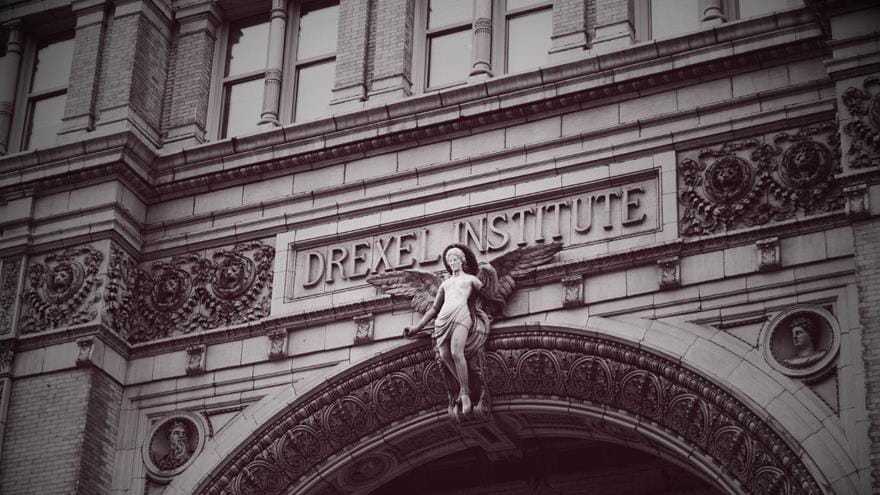The Chocolate Factory on Campus and Other Past Lives of Drexel’s University City Buildings

This article is part of the DrexelNow “Faces of Drexel” series honoring Drexel’s history as part of the University-wide celebration of the 125th anniversary of Drexel’s founding in 1891.
For its first couple of decades, all of Drexel existed in one structure: Main Building. Today, Drexel has three campuses, with over 50 buildings built around its first home on the University City Campus — buildings, and public spaces, that would have been known as very different locations to Drexel students of the past (as well as West Philadelphia residents in the time before the institution even existed).
Here are five examples of the past lives of areas on today’s University Campus that have greatly changed over the course of 125 years (and then some).
Main Building:
Main Building housed all of the then-Drexel Institute of Arts, Science and Technology — all classrooms, offices, a library, a museum and a gymnasium — when the school was founded in 1891. Today, it is still used for academic and administrative purposes.
The acre of land upon which Main Building was built used to be the site of what was called the “Black Castle” (a large wooden mansion painted a dark color) on the northeast corner of Chestnut and Mansion (now 32nd) streets. Originally built around 1820 by an Englishman, the building was purchased by Joseph S. Keen, a successful lumber merchant, in 1830 and he lived there until he died in 1883. The executors of his estate sold the deteriorating house to founder Anthony J. Drexel, who started construction of Main Building in 1889.
Paul Peck Alumni Center
The Paul Peck Alumni Center on 31st and Market streets once housed the Centennial National Bank, which was built in 1876 to serve as the fiscal agent of the Centennial Exposition. Designed by noted Philadelphia architect Frank Furness, the building was named to the National Register of Historic Places in 1971.
Before the Centennial National Bank, the site used to house “The Mansion,” which was known as the oldest house for miles. Thomas P. Hoopes, a millionaire hardware merchant and the second President of the Philadelphia Board of Trade (a precursor to today’s Greater Philadelphia Chamber of Commerce), owned the building as well as an adjoining hardware store. He died in 1872 and the land was acquired to build the Centennial Bank.
Drexel purchased the building in 1976 and it was renovated and opened in 2001 as the Paul Peck Alumni Center, named to honor alumnus Paul Peck ’64. Currently, it is used for office space and exhibit pieces from the founder’s personal art collection that he bequeathed to Drexel.
Mario Statue
Since 2002, the “Mario the Magnificent” bronze statue on 33rd and Market streets has been a popular spot on campus for people to relax and take pictures. Who knows how busy that spot would be if it were still a candy factory?
From the early 1890s to the 1930s, a huge candy factory owned by Croft & Allen Co. operated on the triangular lot at 33rd and Market streets. Samuel Croft, a co-founder of what is now known as the Wilbur Chocolate Company, started the company, which became known for its breakfast cocoa and Swiss milk cocoa. Croft & Allen Co. was sold to the Wilbur Chocolate Company in the 1930s due to the Great Depression.
Rush Building
The current home of the College of Computing & Informatics used to be a tuberculosis ward. The building on the corner of 33rd Street and Lancaster Avenue used to be known as the Hospital for the Treatment of Consumption and Related Diseases. The building, known then and now as the Rush Building, was named for Benjamin Rush, a renowned Philadelphia doctor and signer of the Declaration of Independence. The hospital was founded around the time of Drexel’s opening and moved to its location near Drexel’s campus in 1904.
The hospital remained operational until 1961, when Drexel purchased the building. After some renovations, the Rush Building, as it is known today, was opened in 1966 as the Graduate School of Library Science.
Ross Commons
The building that houses Drexel’s Ross Commons and Sabrina’s Café was originally built in 1888 by Bavarian immigrant, Pennsylvania Railroad tycoon and man-about-town Max Riebenack. In 1928, Drexel acquired the building and three separate plots of land owned by the Riebenack estate for $125,000 (about $1.7 million today).
Drexel opened the Early Childhood Center and the Practice House in the building to be used by the Domestic Science and Arts Department. Students learned homemaking skills like “top-down” dusting and practiced caring for real babies that are believed to have come from a nearby orphanage.
In 1991, an electrical fire on the first floor daycare closed the building for the next 10 years. Alumnus and former chairman of the board of trustees George Ross ’55, Hon. ’99, made a generous donation in 2001 to restore the house.
In This Article
Drexel News is produced by
University Marketing and Communications.

